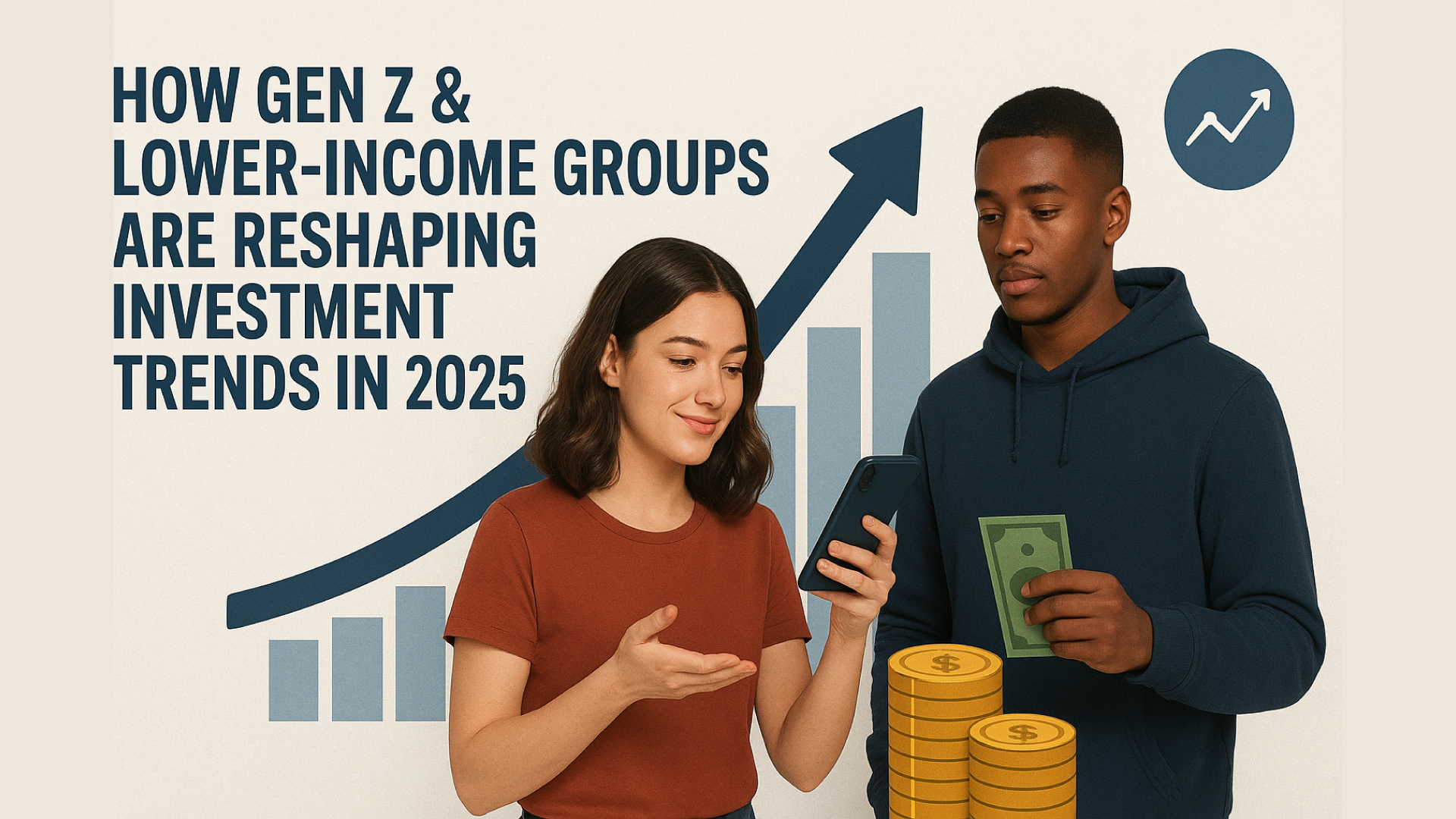How Gen Z & Lower-Income Groups Are Reshaping Investment Trends in 2025
The year 2025 has marked a profound shift in the financial landscape. For decades, investing was often perceived as the domain of the wealthy, the well-educated, or those with long-standing exposure to Wall Street culture. But the tides are turning. Gen Z investing trends, alongside a remarkable rise in participation from lower-income groups, are reshaping the very foundations of wealth-building strategies across the globe.
Unlike previous generations, who placed homeownership or traditional savings accounts at the center of financial security, Gen Z is demonstrating a clear preference for investment-first strategies. Coupled with easier access to digital platforms, broader financial literacy campaigns, and the widespread democratization of trading apps, this new investor class is rewriting the rules of the financial marketplace.
- The Rise of Gen Z in the Investment World
- Lower-Income Investors Enter the Market
- The Role of Financial Literacy
- Challenges Facing New Investors
- The Shift Away from Homeownership
- How Financial Institutions Are Responding
- Wealth-Building Strategies for New Investors
- The Global Picture: Beyond the U.S.
- Future Outlook
- Conclusion
The Rise of Gen Z in the Investment World
Born between the mid-1990s and early 2010s, Generation Z has come of age in a world dominated by smartphones, social media, and instant access to information. Their approach to money, risk, and opportunity is fundamentally different from Baby Boomers or even Millennials. According to recent market reports, nearly 40% of Gen Z adults now have some form of stock market exposure, with participation rates climbing rapidly year-over-year.
Factors Driving Gen Z’s Investment Surge
- Technology Access: Easy-to-use apps like Robinhood, Zerodha, and Coinbase have removed traditional barriers to entry.
- Financial Independence Goals: Gen Z places less emphasis on fixed assets like housing, preferring financial flexibility through investments.
- Influence of Social Media: TikTok, YouTube, and Instagram influencers play a role in shaping young investors’ decisions—both positively and negatively.
- Economic Reality: With housing costs and inflation rising, many young people see investing as the only viable route to wealth.
Lower-Income Investors Enter the Market
Perhaps even more surprising than Gen Z’s involvement is the sudden surge of participation from lower-income investors. Once considered unlikely to prioritize investments due to limited disposable income, this group is increasingly putting small amounts of money into mutual funds, ETFs, and even fractional shares of blue-chip stocks.
Why Are Lower-Income Groups Investing Now?
- Fractional Ownership: Platforms now allow individuals to buy fractions of stocks for as little as $1, lowering the barrier to entry.
- Digital Wallet Integration: Seamless connection between banking apps and trading platforms simplifies the process.
- Shift in Mindset: Rather than saving for years before making major purchases, younger investors are choosing to invest steadily in small increments.
- Inflation Concerns: Savings accounts yield minimal returns, pushing people to seek better growth in markets.
The Role of Financial Literacy
One of the defining features of this trend is the emphasis on financial education. Gen Z and lower-income investors are consuming content at unprecedented levels. Online courses, YouTube channels, and even TikTok creators specializing in money management have empowered millions of new participants.
Key Areas of Learning
- Understanding dollar-cost averaging as a risk management tool.
- Basics of asset allocation across equities, bonds, and digital assets.
- The importance of emergency funds before speculative investments.
- Long-term wealth-building strategies vs. short-term trading temptations.
Challenges Facing New Investors
Despite the positive trend, challenges abound. Gen Z investors and lower-income participants are particularly vulnerable to market volatility, misinformation, and emotional decision-making. The temptation to chase meme stocks, cryptocurrencies, or speculative penny stocks often results in losses that could discourage sustained participation.
Major Risks Identified
- Mental Pressure: The volatility of markets can cause stress, especially for those with limited financial buffers.
- Overexposure to Social Media: While social platforms spread financial literacy, they also amplify risky and misleading strategies.
- Limited Savings Cushion: Lower-income investors risk losing essential funds needed for emergencies.
The Shift Away from Homeownership
One of the most profound long-term consequences of these shifts is the decline in prioritization of homeownership. In previous decades, owning a house was considered the ultimate measure of financial success. Today, surveys reveal that fewer than 30% of Gen Z list homeownership as a primary goal, compared to 60% of Baby Boomers at the same age.
Instead, young people view wealth as the ability to be flexible, mobile, and financially free—goals that align better with liquid investments than fixed assets.
How Financial Institutions Are Responding
Banks, fintech companies, and traditional brokerage firms are rapidly adapting to capture this growing audience. Some strategies include:
- Launching micro-investment platforms that allow round-up investments from everyday purchases.
- Expanding educational resources targeted specifically at Gen Z audiences.
- Developing ESG (Environmental, Social, Governance) products, as younger investors show stronger preference for ethical investments.
Wealth-Building Strategies for New Investors
For those just beginning their investment journey, experts recommend sticking to tried-and-true strategies while avoiding the lure of quick wins.
Top Recommendations
- Start with Dollar-Cost Averaging: Investing a fixed sum regularly helps mitigate market volatility.
- Focus on Index Funds & ETFs: These provide diversified exposure with relatively lower risk.
- Prioritize Long-Term Goals: Short-term trading can be risky without significant experience.
- Build a Safety Net: Maintain at least 3–6 months of emergency savings before allocating funds aggressively.
- Seek Financial Advice: Consult professionals or certified advisors before making large commitments.
The Global Picture: Beyond the U.S.
This trend isn’t confined to the United States. Across India, Southeast Asia, and parts of Africa, similar patterns are emerging. In India, for instance, the number of retail Demat accounts has doubled in just five years, fueled largely by young and first-time investors. In Nigeria, mobile investment platforms are attracting lower-income groups previously excluded from formal financial markets.
Case Studies
- India: Platforms like Zerodha and Groww have attracted millions of Gen Z investors through simplified onboarding.
- Africa: Startups like Bamboo and Chaka are opening up access to U.S. and global stocks for first-time African investors.
- Europe: EU-based neo-brokers are tailoring sustainable investment products that resonate with Gen Z’s values.
Future Outlook
If the current trajectory continues, by 2030 Gen Z and lower-income investors could represent one of the largest segments of global market participants. Their collective influence may push corporations to become more transparent, demand ethical operations, and create new categories of investment products designed specifically for this demographic.
However, financial literacy, regulation, and responsible risk management will be critical. Governments, institutions, and educators must collaborate to ensure that this powerful trend results in long-term financial security rather than widespread disillusionment from preventable losses.
Conclusion
The rise of Gen Z investing trends and the growing involvement of lower-income groups in the stock market represent one of the most significant financial shifts of our time. By embracing new technologies, demanding flexibility, and prioritizing wealth over ownership, these groups are setting the tone for the next era of financial evolution. For businesses, policymakers, and financial institutions, the message is clear: adapt to this wave of democratized investing, or risk being left behind.
In short, the future of investing is no longer reserved for the elite. It is open, inclusive, and rapidly transforming—driven by the determination of a new generation and those once excluded from wealth-building opportunities.



